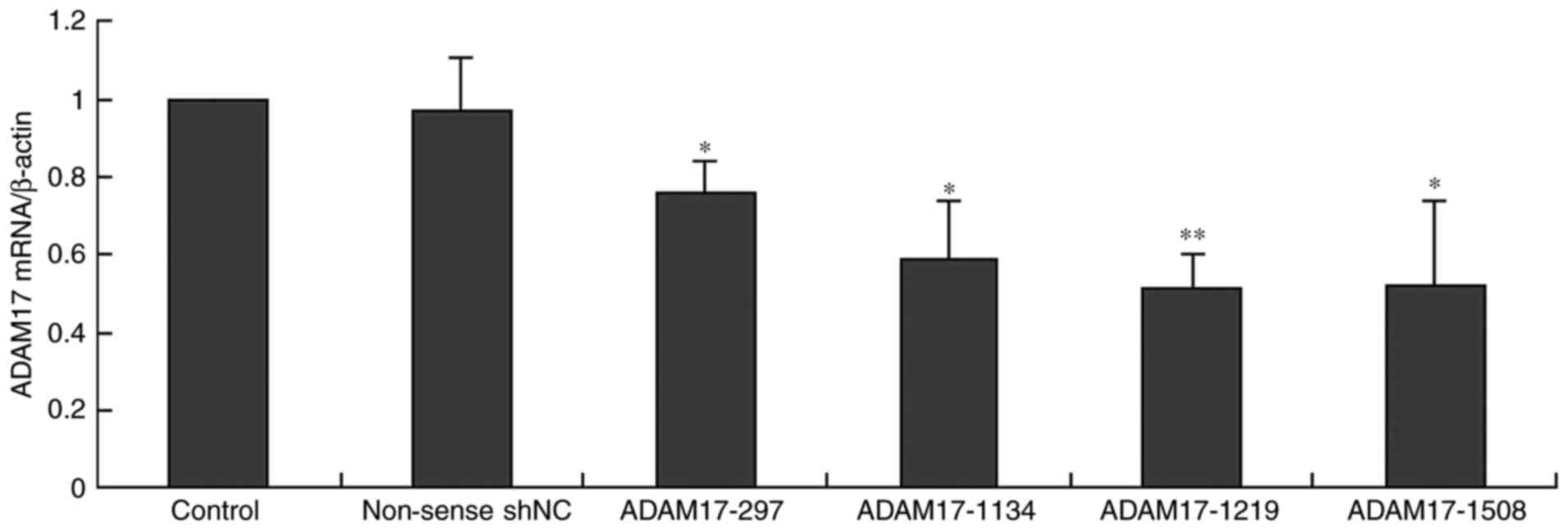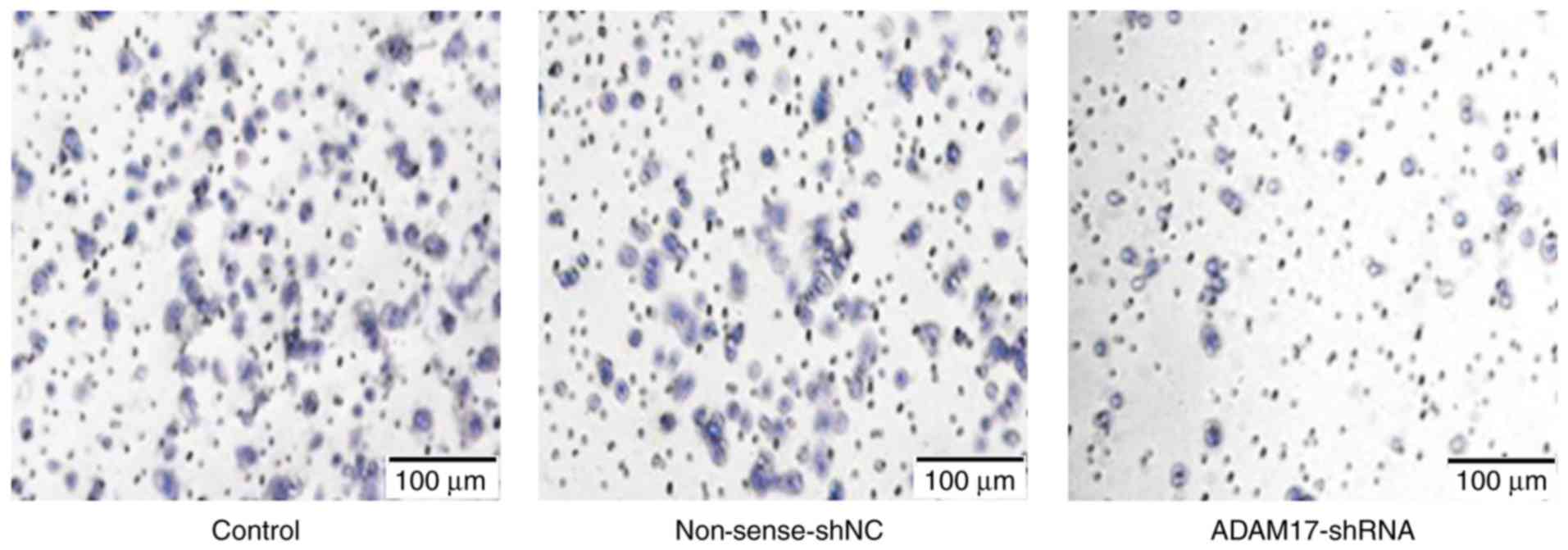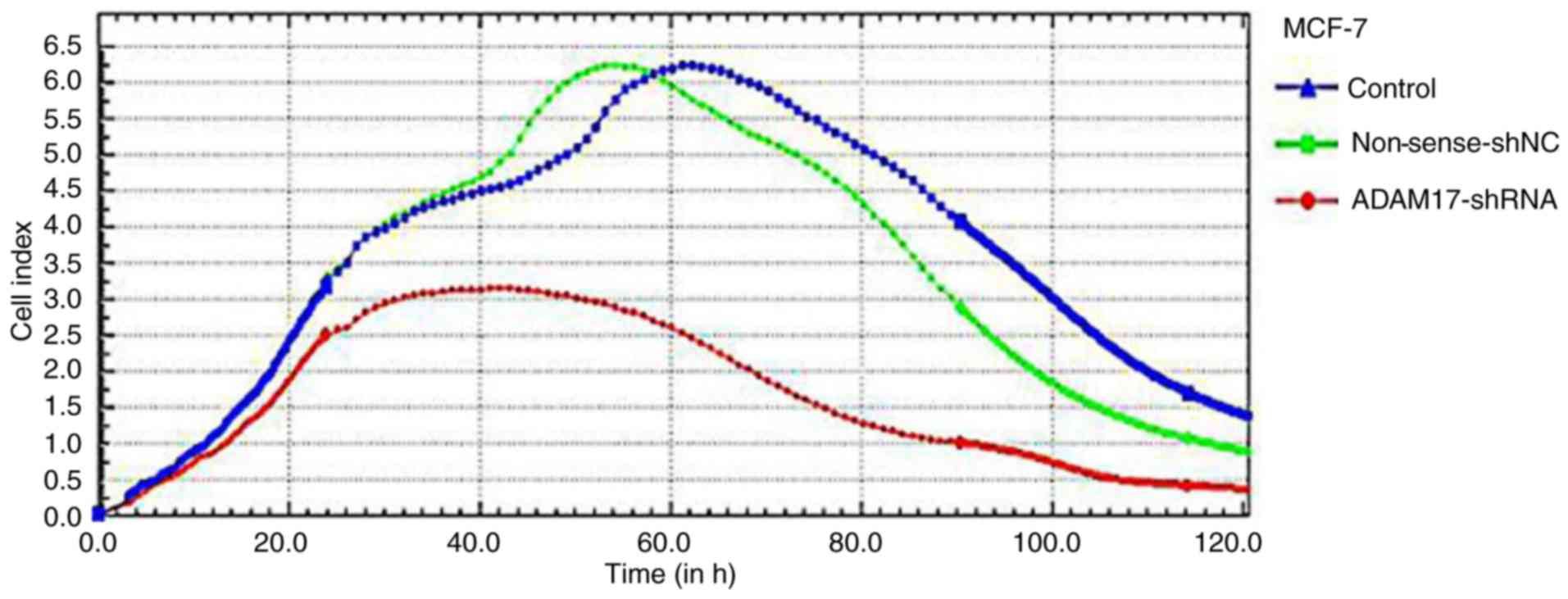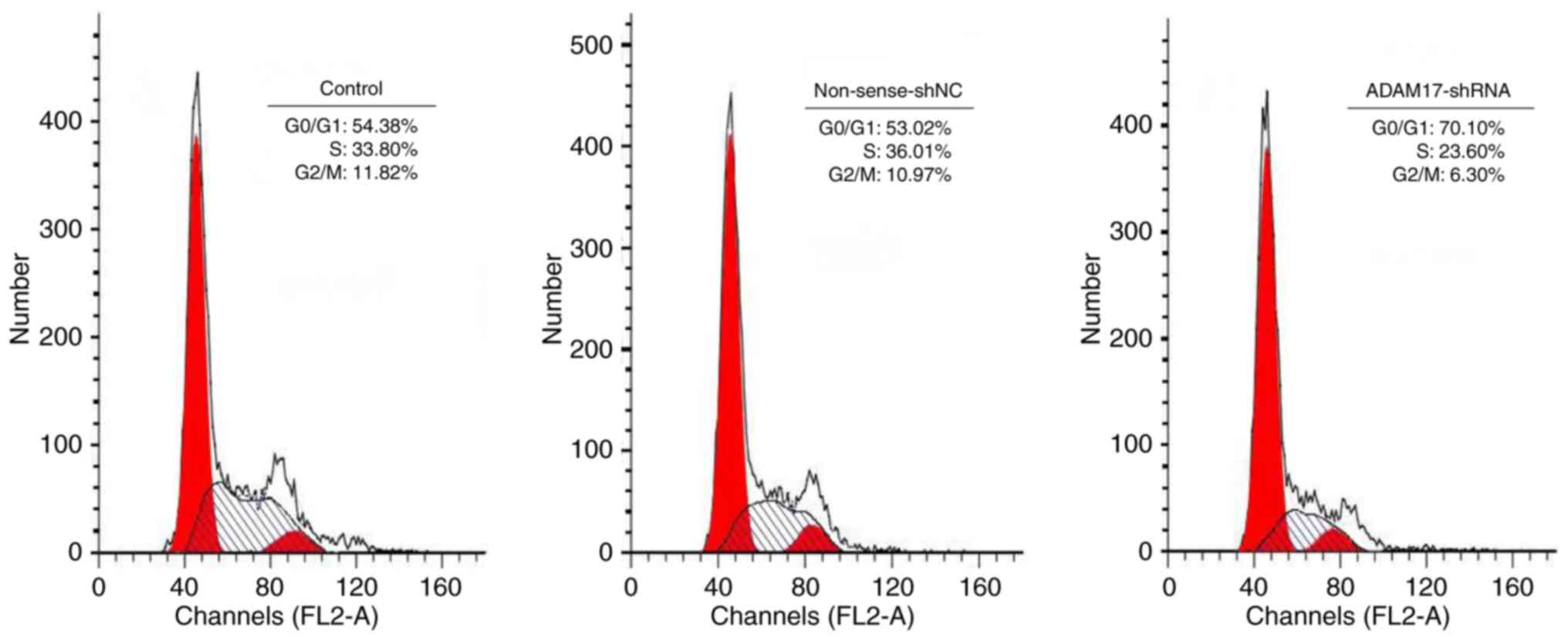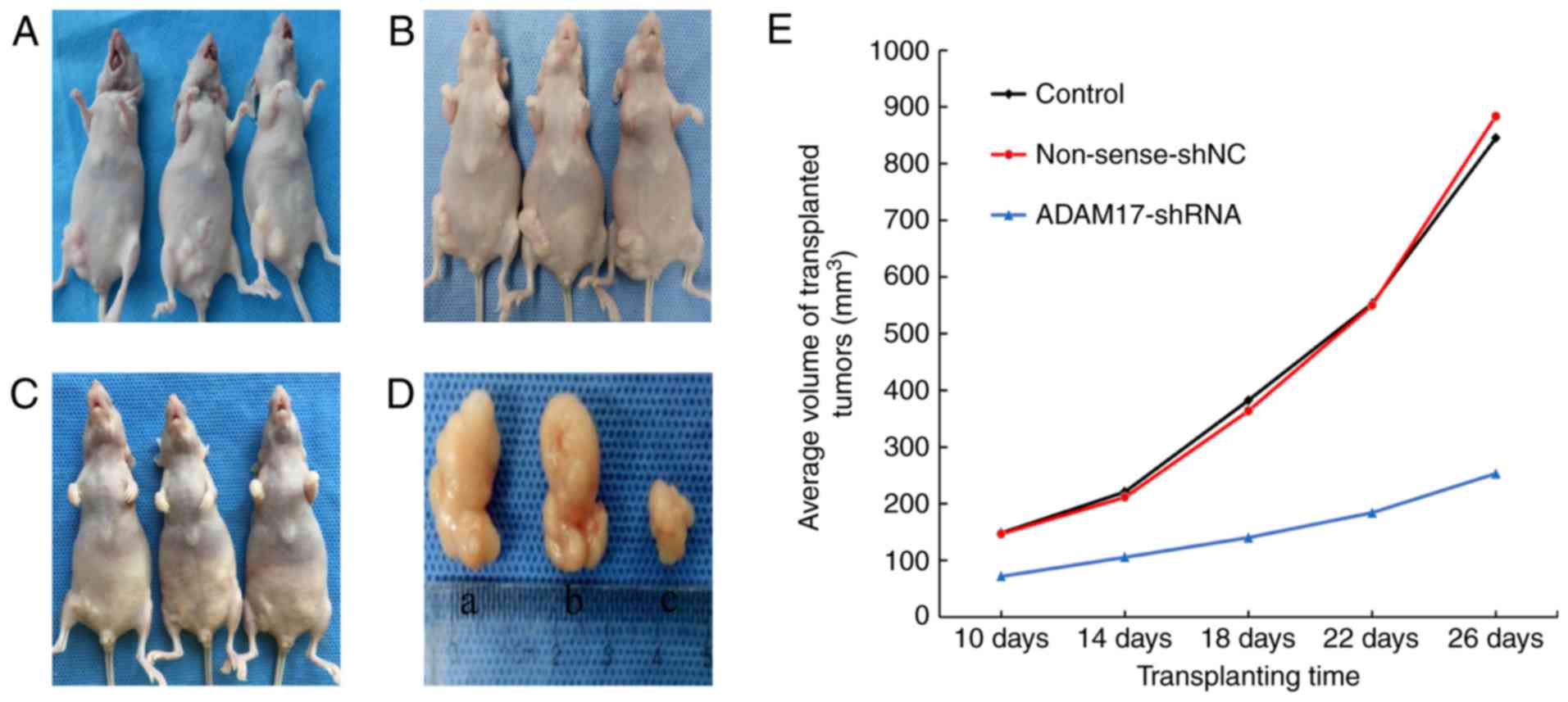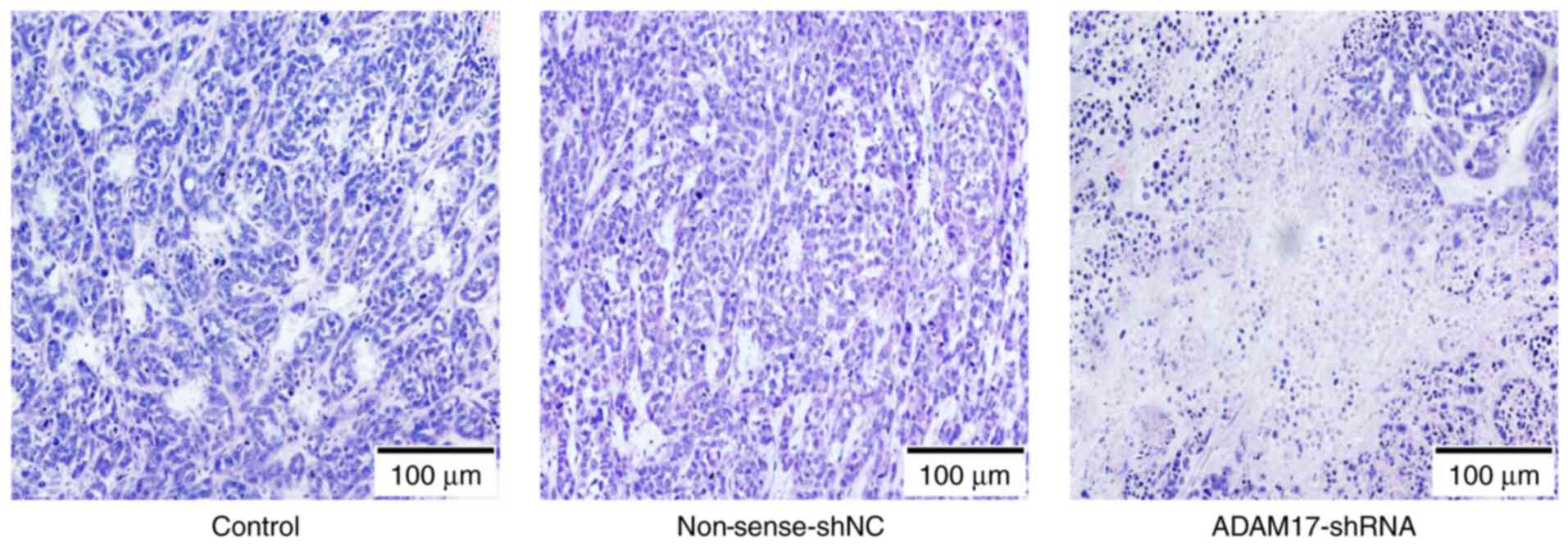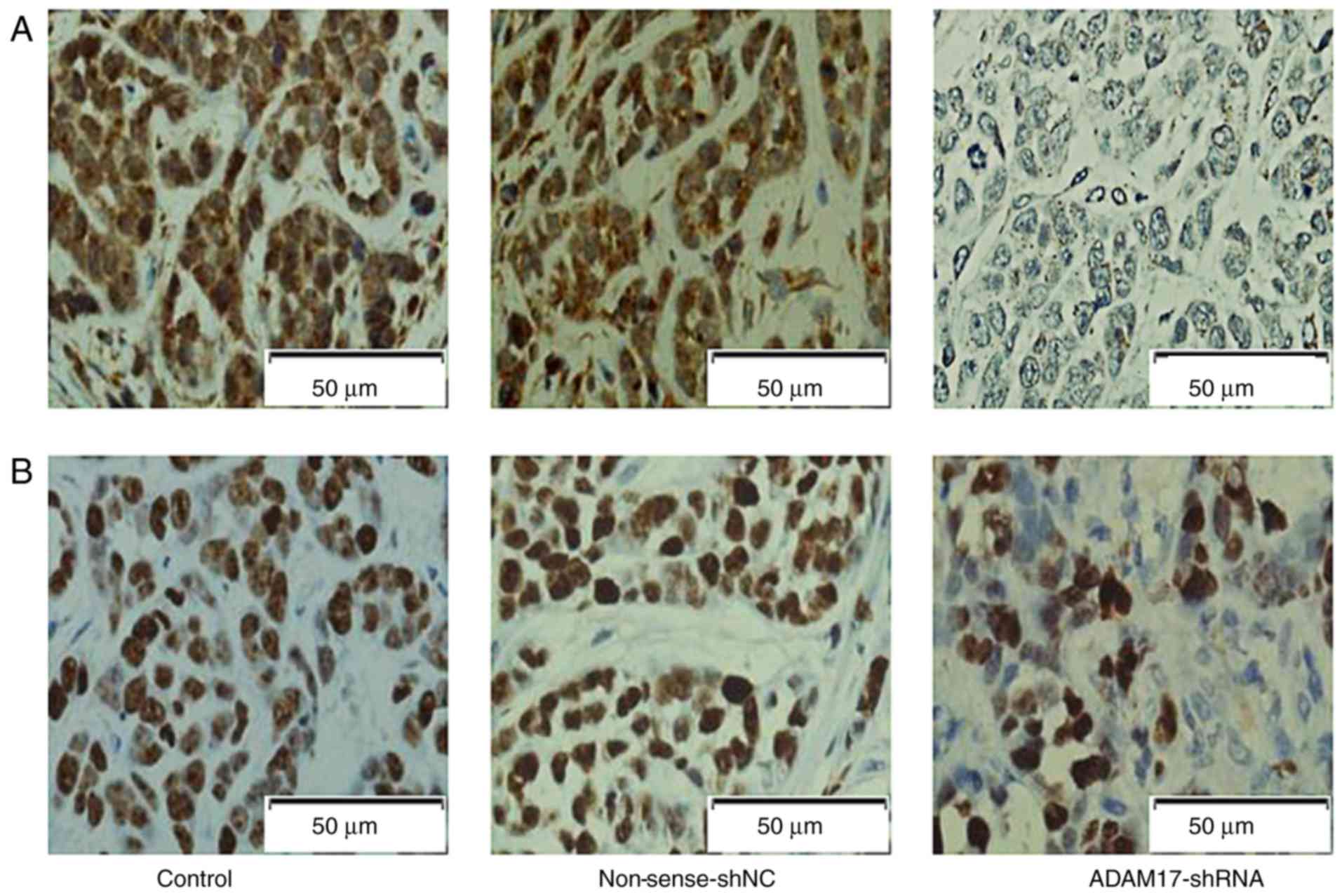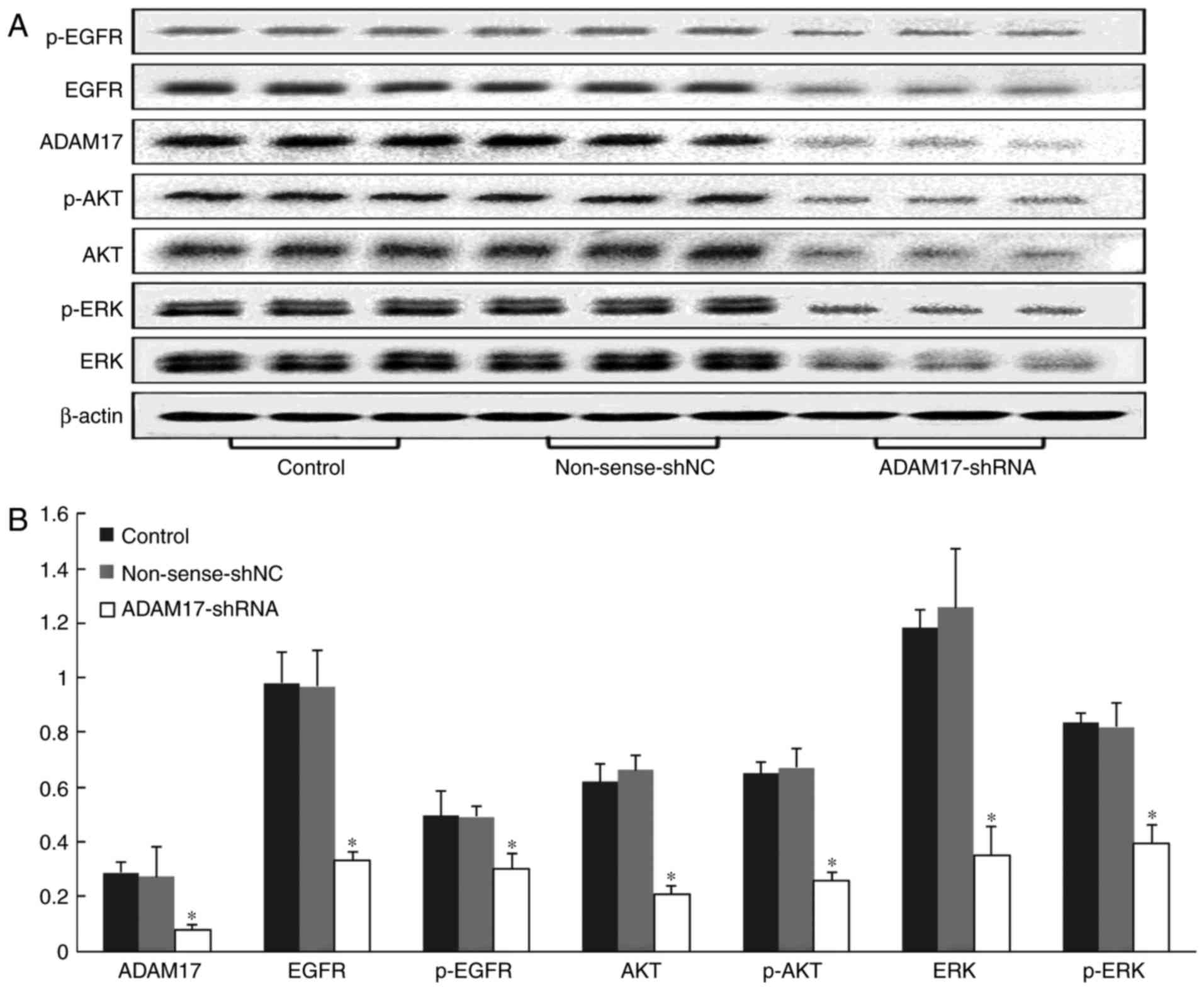Short hairpin RNA-mediated gene silencing of ADAM17 inhibits the growth of breast cancer MCF‑7 cells in vitro and in vivo and its mechanism of action
- Authors:
- Published online on: January 26, 2018 https://doi.org/10.3892/or.2018.6237
- Pages: 1640-1648
-
Copyright: © Hu et al. This is an open access article distributed under the terms of Creative Commons Attribution License.
Abstract
Introduction
According to the 2012 survey conducted by the International Agency for Research on Cancer (IARC), there are nearly 1.7 million women suffering from breast cancer and ~520 thousand individuals succuumb to this disease each year worldwide, with a rising incidence rate affecting younger women (1). For the past decade, molecular-targeted therapy, targeting a particular gene or protein which can play a pivotal role in the occurrence and development of malignant tumors, instead of cytotoxic drugs, has gradually become a ‘hotspot’ in cancer treatment research (2). Currently, in this field, studies concerning downstream genes or proteins of the epidermal growth factor receptor (EGFR) have emerged in an endless stream, but research focusing on its upstream genes or proteins is rare (3). A disintegrin and metalloprotease 17 (ADAM17) is a cell membrane glycoprotein, originally known for its ability to cleave and activate tumor necrosis factor-α (TNF-α); thus, it is also named TNF-α converting enzyme (TACE) (4,5). However, upon release of TNF-α, ADAM17 also processes various growth factors and receptors. Thus, it promotes the development of various diseasess, and particularly participates in the activation of EGFR, which is closely related to the progression of many malignant tumors (6,7). ADAM17 is highly expressed in breast cancer, prostate and colorectal cancer and glioma, playing a ‘signal scissor’ role in the tumor microenvironment (8,9). It can cut a series of EGFR ligands, such as epidermal growth factor (EGF), transforming growth factor-α (TGF-α), betacellulin (BTC), amphiregulin (AREG), neuregulin (NRG), epiregulin (EREG) and various inflammatory factors, particularly TNF-α (10,11). EGFR ligand-binding leads to receptor self-dimerization, autophosphorylation followed by the activation of downstream MEK/ERK and PI3K/AKT pathways, thereby promoting tumor cell proliferation, invasion and metastasis (12,13). In recent years, the action of ADAM17 in breast cancer has attracted increased attention. In this respect, there has been a large number of studies on the expression of ADAM17 based on clinical samples, cells and animal models. Expression of ADAM17 is weak in normal breast tissues, but is significantly increased in breast cancer, and becomes higher with an increase in the degree of malignancy, clinical stage and lymph node metastasis of breast cancer (14). ADAM17 was found to exhibit higher expression in highly malignant breast cancers when compared to that in low malignant cancers, and patients with high ADAM17 expression were found to have a visibly reduced overall survival than those with low expression, which implies that ADAM17 may be a favorable breast cancer therapeutic target (15,16). Our previous study found that the migration and proliferation of MCF-7 breast cancer cells can be inhibited by the silencing of ADAM17 via the EGFR/PI3K/AKT signaling pathway in vitro, and MCF-7 cell xenograft growth was also inhibited by ADAM17-siRNA in vivo (17). Our present study found that ADAM17-shRNA suppresses MCF-7 breast cancer cell growth in vitro and in vivo through the EGFR/PI3K/AKT and EGFR/MEK/ERK signaling pathways.
Materials and methods
Cell line and cell culture
MCF-7 cell culture was conducted as previously described (17). The MCF-7 human breast cancer cell line was obtained from the Institute of Basic Medical Sciences, Chinese Academy of Medical Sciences (Beijing, China).
Transfection of MCF-7 cells with lentivirus-ADAM17-shRNA-GFP
As shown in Table I, four ADAM17-shRNAs and one non-sense-shNC were designed by GenePharma (Shanghai, China). Each gene carrier contained an expression framework of green fluorescent protein (GFP) which could be expressed in transfected cells. Thus, the transfection efficiency was evaluated under a Nikon® Eclipse Ti-U inverted fluorescence microscope (Nikon, Tokyo, Japan). MCF-7 cells in the ADAM17-shRNA and non-sense-shNC groups were transfected using a lentivirus following the manufacturer's instructions. An equal volume of PBS solution was added to the cells of the control group.
Quantitative real-time polymerase chain reaction (qRT-PCR)
qRT-PCR experiments were performed as previously described (17).
Invasion assays in vitro
Invasion of MCF-7 cells was performed using 24-well Transwell chambers with 8.0-µm pore polycarbonate membranes covered with Matrigel (BD Biosciences, San Jose, CA, USA). After trypsinization, cells of the ADAM17-shRNA, non-sense-shNC and control groups were suspended in DMEM, respectively, with the cell concentration adjusted to 5×105/ml. The subsequent experimental procedure, except the cut polycarbonate membrane stained with hematoxylin, and counting method were identical to that as previously described (17). The number of cells that invaded through the Transwell chamber was an indicator to evaluate invasive ability.
Real-time cell analysis
The effect of ADAM17-shRNA on MCF-7 cell proliferation was monitored in real-time using the iCELLigence system (ACEA Biosciences, San Diego, CA, USA). In brief, 150 µl DMEM containing 10% FBS was dropped in each E-Plate L8 well (ACEA Biosciences) and then the E-Plates were inserted into the iCELLigence instrument for background measurement. MCF-7 cells of the ADAM17-shRNA, non-sense-shNC and control groups were trypsinized and plated at a concentration of 3×104/well into the E-Plate L8 in a final volume of 450 µl, respectively, and were incubated at room temperature for 30 min. Afterwards, E-Plates were inserted again, and iCELLigence assay was performed. Cell adhesion, growth, and proliferation process were detected by measuring electrical impedance and recorded for 120 h. Cell index (CI) which reflects the number of viable cells was calculated for each E-plate well and the CI curve was obtained with iCELLigence DA Software 1.0 (ACEA Biosciences). The experiments were conducted in triplicate.
Flow cytometry
The effect of ADAM17-shRNA on the cell cycle distribution of MCF-7 cells was detected by flow cytometric (FCM) analysis. MCF-7 cells (1×106) during the logarithmic growth phase in the ADAM17-shRNA, non-sense-shNC, and control groups were seeded in 25-cm3 culture flasks, respectively, and maintained for 24 h. Following washing with PBS and trypsinization, the cells were then collected and fixed with 75% ethanol at 4°C overnight. After centrifugation, the cells were incubated with PBS containing 50 µg/ml propidium iodide (PI) (Sigma, St. Louis, MO, USA) and 100 µg/ml RNase A (Invitrogen, Carlsbad, CA, USA) in darkness at 37°C for 30 min. Finally, the cells were subjected to flow cytometric analysis using the FACSCalibur flow cytometer (BD Biosciences). Each experiment was repeated 3 times.
Effect of ADAM17-shRNA on the growth of MCF-7 breast cancer cells in vivo
Female (nu/nu) athymic mice with a weight of 15–25 g were purchased from Beijing HFK Bioscience Co., Ltd. (Beijing, China). Estrogen (0.2 ml) (0.15 mg/ml) was injected into the peritoneal cavity of the nude mice every day until sacrifice. Fifteen nude mice were randomly divided into three groups: ADAM17-shRNA, non-sense-shNC and control group. MCF-7 (0.2 ml) breast cancer cells (5×107/ml) with three different treatments were subcutaneously implanted in the right flank of the nude mice, respectively, after 3 days of estrogen injection. From the 10th day after implantation, with visable emergence of the tumor nodule, the tumor diameter was measured with calipers every 4 days and the tumor volume (V) was calculated by the formula: V = (width)2 × length/2. Mice were sacrificed on day 26 after cell implantation. The mice were euthanized by cervical dislocation. This study was conducted in accordance with the ethical standards according to national and international guidelines, and all experimental procedures were approved by the Institutional Review Board of North China University of Science and Technology.
Immunohistochemistry of tumor tissues
Immunohistochemical staining analysis of ADAM17 and Ki-67 in the tumor tissues from the different groups was carried out as previously described (17).
Western blotting
Western blotting was performed as previously described (17) with the following modifications. Proteins were separated on 8% SDS-PAGE and two antibodies: anti-ERK (1:1,000) and anti-phosphorylated ERK (1:1,000) (both from Santa Cruz Biotechnology, Inc., Santa Cruz, CA, USA) were used.
Statistical analysis
Results are showed as mean ± SD. Data were considered statistically significant when the value of P<0.05. Comparisons among 3 or more groups were made by one-way ANOVA using SPSS 13.0 software (SPSS, Inc., Chicago, IL, USA). All experimental procedures were approved by the Institutional Animal Care and Use Committee of North China University of Science and Technology.
Results
Transfection efficiency
After transfection with a multiplicity of infection (MOI) set to 100 and continuous culture for 72 h, the cells were observed under the Nikon® Eclipse Ti-U inverted fluorescence microscope. According to the expression of the GFP, the transfection efficiency of this experiment reached >90%. This verified that the lentivirus transferred ADAM17-shRNA to the MCF-7 cells efficiently (Fig. 1).
ADAM17 mRNA expression was silenced by ADAM17-shRNA in MCF-7 cells
To observe whether ADAM17 expression was inhibited by ADAM17-shRNA, ADAM17 mRNA levels in MCF-7 cells transfected with ADAM17-shRNAs and non-sense-shNC were detected by qRT-PCR. The relative quantity of ADAM17 mRNA in the control group was considered as 100% after β-actin corrections. Our results revealed that ADAM17 mRNA was highly expressed in the MCF-7 cells (control), and non-sense-shNC did not change ADAM17 mRNA expression, while all ADAM17-shRNAs inhibited the expression (P<0.05, Fig. 2), particularly ADAM17-1219 (P<0.01). Thus, we omitted the other shRNAs in the following experiments. This data showed that ADAM17 expression was successfully inhibited by ADAM17-shRNA at the mRNA level.
Invasion of MCF-7 breast cancer cells
Transwell chamber method was used to test the invasive ability of the MCF-7 cells. The average number of invaded cells in each field was 101.75±4.25, 99.13±6.08 and 57.42±3.95 in the control, non-sense-shNC and ADAM17-shRNA groups, respectively (Fig. 3). There was no statistical difference between the control and the non-sense-shNC group (P>0.05). However, the number was reduced significantly in the ADAM17-shRNA group (P<0.05). The results revealed that ADAM17 enhanced MCF-7 cell invasion and ADAM17-shRNA successfully inhibited the invasive ability of the breast cancer cells.
CI curve by iCELLigence system
Using the iCELLigence microelectronic biosensor system, the real-time analysis of MCF-7 cell proliferation was performed. As shown in Fig. 4, cells of the control and non-sense-shNC group both displayed high increases and high levels in CI, but the growth rate and proliferative activity did not achieve a significant different (P>0.05). However, the CI of the ADAM17-shRNA group maintained a shorter increase and significantly lower level than that of the other two groups, which implies a slowed cell growth rate and decreased proliferative activity (P<0.05). Thus, the iCELLigence assay showed that ADAM17-shRNA effectively inhibited the proliferation of the MCF-7 cells.
ADAM17-shRNA induces G0/G1 cell cycle arrest in MCF-7 cells
To further examine the antitumor effect of ADAM17-shRNA, cell cycle progression in MCF-7 cells was investigated. The percentage of cells in each phase of the cell cycle was measured by flow cytometry (Fig. 5). There was no significant difference in the percentage of G0/G1, S and G2/M phase cells between the control and non-sense-shNC group (P>0.05). However, when MCF-7 cells were transfected with ADAM17-shRNA, an accumulation of the cell population in the G0/G1 phase was significantly increased, accompanied by a decrease in the percentage of cells in the S and G2/M phases (P<0.05). These results indicated that ADAM17-shRNA resulted in G0/G1 phase arrest of MCF-7 cells, eventually inhibiting the growth of MCF-7 cells.
Inhibition of tumor growth by ADAM17-shRNA
The size of the transplanted tumors was observably increased (a and b in Fig. 6D) in the control group (Fig. 6A) and the non-sense-shNC group (Fig. 6B), but was significantly smaller (c in Fig. 6D) in the ADAM17-shRNA group (Fig. 6C) than the other two groups (P<0.05). The tumor growth curve (Fig. 6E), drawn from the average tumor volumes of the different groups, showed that the transplanted tumors maintained a sustained and rapid growth trend in the control and non-sense-shNC groups, but increased slowly in the ADAM17-shRNA group.
Microscopic features of the transplanted tumor tissues
Hematoxylin and eosin (H&E) staining displayed that the transplanted tumors were characterized by breast invasive ductal carcinoma (cords of breast cancer cells, interstitial invasion and hemorrhage). There was no obvious difference between the control and non-sense-shNC group. Compared with the other two groups, the tumor tissue of the ADAM17-shRNA group developed larger areas of necrosis, in which the cells were destroyed and cell structures had disappeared (Fig. 7).
ADAM17 and Ki-67 in tumor tissues as detected by immunohistochemistry
ADAM17, shown as positive brown staining, was mostly expressed in the cytoplasm. The staining index score was 7.17±0.27, 7.11±0.21 and 2.65±0.49 in the control, non-sense-shNC and ADAM17-shRNA group, respectively. The scores indicated a significant decrease in the ADAM17-shRNA group (P<0.01, Fig. 8A), but had no statistical difference between the control and non-sense-shNC group (P>0.05). The results suggested that ADAM17-shRNA inhibited ADAM17 expression in transplanted tumors.
Ki-67, shown as positive brown staining, was mostly expressed in the nucleus. The staining index score was 9.05±0.34, 8.94±0.42 and 3.76±0.23 in the control, non-sense-shNC and ADAM17-shRNA group, respectively. The scores indicated a significant decrease in the ADAM17-shRNA group (P<0.01, Fig. 8B), but no statistical difference was noted between the control and non-sense-shNC group (P>0.05). The results indicated that ADAM17-shRNA inhibited Ki-67 expression in the transplanted tumors.
Exploration of the mechanism underlying the inhibition of breast cancer growth by ADAM17-shRNA
To further reveal the mechanism of ADAM17-shRNA against MCF-7 breast cancer growth, expression of related proteins in the transplanted tumors were tested by western blotting. The results showed that there was high expression of ADAM17, EGFR, phosphorylated (p)-EGFR, AKT, p-AKT, ERK and p-ERK, both in the control and non-sense-shNC groups; however, administration of ADAM17-shRNA significantly reduced these proteins compared with the other two groups (P<0.01, P<0.01, P=0.01, P<0.01, P<0.01, P<0.01, P<0.01, respectively, Fig. 9). These data indicated that EGFR, p-EGFR, AKT, p-AKT, ERK and p-ERK were downstream of ADAM17 and were involved in the inhibition of MCF-7 breast cancer cells by ADAM17-shRNA in vivo.
Discussion
ADAM17 is expressed in almost all cells of the human body, but only obviously when inflammation or cancer occurs (18). It can cut some membrane-bound growth factors, growth factor receptors or cytokines in the extracellular domain, making them activated or released, thereby modulating a variety of cellular biological behaviors, which is causally related to neurodevelopment, aging, viral transmission, immune response and tumorigenesis (8,18).
Our previous study found that migration and proliferation of MCF-7 breast cancer cells were inhibited by ADAM17-siRNA via the EGFR/PI3K/AKT signaling pathway in vitro, and MCF-7 cell xenograft growth was also inhibited by ADAM17-siRNA in vivo (17). However, siRNA cannot self-replicate and is easy to be diluted and degraded in the process of cell differentiation, resulting in a short duration of silencing action (usually lasting 3–7 days). Once siRNA disappears in the transfected cells, the function of the target gene can be restored to the level of pre-transfection. This limitation makes siRNA only an effective tool for short-term analysis of gene function (19). Thus, in our current project, we transfected MCF-7 cells with ADAM17-shRNA and that siRNA sequence was cloned into the plasmid vector as ‘short hairpin’. When entering a cell, the hairpin sequence can be automatically processed into siRNAs, which enable target gene silencing. Therefore, loading the carrier of the shRNA can be passed to the progeny cells so that the silencing of genes can be inherited (19,20). Lentivirus can infect both mitotic and non-mitotic cells, and the RNA interference sequence that it carries can be randomly inserted and integrated into the genome of the host cell for long-term expression (21,22). Thus, the aim of long-term stable silencing of the ADAM17 gene can be achieved.
Cell proliferation and invasion are essential to the development of cancers, which are complicated activities regulated by many types of factors (23). Some studies have confirmed that ADAM17 can enhance proliferation and invasion of breast cancer cells (2,24,25). In the present study, the MCF-7 cell line was employed for the research of ADAM17-shRNA against the proliferation and invasion of breast cancer in vitro. Prior to this, we maintained cell transfection efficiency above 90% using a lentivirus, in order to provide full efficacy of ADAM17-shRNA. The qRT-PCR data showed that our shRNA successfully inhibited ADAM17 expression at the mRNA level. Real-time cell analysis and Transwell chamber assay showed that ADAM17-shRNA effectively blocked proliferation and invasion of MCF-7 cells, and flow cytometric analysis further confirmed that ADAM17-shRNA resulted in a G0/G1 phase arrest of the MCF-7 cells. The results suggest that ADAM17-shRNA can inhibit breast cancer metastasis to other organs.
Thereafter, the antitumor effects of ADAM17-shRNA were detected in vivo. Xenograft models of MCF-7 breast cancer were established in nude mice to observe whether ADAM17-shRNA could inhibit tumor growth. The results showed that ADAM17-shRNA slowed the growth of transplanted tumors and induced tumor necrosis. As a valuable biological marker for assessing the proliferative activity of tumor cells, Ki-67 has demonstrated positive results in a variety of malignancies, particularly in breast cancer (26,27). It is often used in clinical work to evaluate the malignant degree of breast cancer and the prognosis of patients (27,28). Our immunohistochemistry results indicated that the expression of ADAM17 and Ki-67 were significantly decreased in the breast cancer tissues transfected with ADAM17-shRNA.
EGFR, a tyrosine kinase type receptor, is widely distributed in all cell surfaces except hematopoietic cells and plays an important regulatory role in the normal physiological process of cells (29). However, overexpression and mutation of EGFR are always associated with malignant tumors (29,30). A recent study found that EGFR expression increases with tumor volume, histological grade, lymph node metastasis and TNM stage of breast cancer, and there are numerous studies on targeting EGFR in breast cancer treatment (31–34). EGFR activation relies on binding ligands (such as EGF, TNF-α) to promote proliferation and invasion of tumor cells. ADAM17 has been proven to play a pivotal role in the progression of EGFR-dependent malignancies by hydrolyzing its ligands (13,16). EGFR ligand-binding may activate the downstream PI3K/AKT and MEK/ERK signaling pathways, which contributes to tumor development (2,12,35). AKT, also known as protein kinase B (PKB), is closely related to the proliferation, apoptosis, and metabolism of normal cells (36). The dysregulation of the PI3K/AKT pathway is associated with diabetes, cardiovascular and neurological diseases, and malignancies (37). Studies have shown that PI3K/AKT pathway signals are overexpressed in breast, liver and lung cancer, soft tissue tumors and other malignant diseases, and are correlated with tumor size (38–40). Our previous study confirmed that AKT signaling is induced by ADAM17, which is involved in MCF-7 cell proliferation and migration (17). However, in the previous study, the MEK inhibitor (PD0325901) was found to have no effect on the proliferation and invasion of MCF-7 cells, and thus was discarded in the subsequent experiments, without further testing the protein expression of the EGFR/MEK/ERK pathway in different treatments and ascertaining its interaction with the ERFR/PI3K/ERK pathway. Various studies have shown that crosstalk exists between the EGFR/PI3K/AKT and EGFR/MEK/ERK pathways (41–43). Phosphorylated AKT can activate the mitogen-activated protein kinase (MAPK) pathway (44). Selective MEK inhibitors can cause the upegulation of PI3K pathway signals, which leads to the drug resistance to the MEK inhibitor in a complex signal network, while the combination of MEK inhibitor and PI3K inhibitor can provide a better therapeutic effect (42,45,46). Thus, we highly suspect that the inhibitory effect of PD0325901 on MEK was obscured by the role of the upregulated PI3K signals through the above mechanism in our last study, so the migration and proliferation of MCF-7 cells were not reduced after PD0325901 administration. Therefore, we considered that the mechanism of ADAM17-shRNA in the inhibition of MCF-7 breast cancer needed further exploration. ERK, an important member of the MAPK family, is confirmed in a variety of cell models to participate in cell apoptosis and cell cycle regulation and play a crucial role in cell proliferation and differentiation (47,48). Excessive expression of the ERK pathway is common in tumors (49,50). It has been proven that ERK and p-ERK expression in breast cancer tissues increases with clinical stage and lymph node metastasis (51). Various studies have reported that the EGFR/MEK/ERK pathway can be activated by ADAM17 (35,52). In the present study, the western blot results showed that expression of EGFR, AKT, and ERK was significant lower in the ADAM17-shRNA group than that in the control and non-sense-shNC groups due to the fact that the growth of the transplanted tumor was markedly inhibited, and p-EGFR, p-AKT and p-ERK expression was also suppressed by ADAM17-shRNA.
Our results above indicated that ADAM17-shRNA can inhibit MCF-7 breast cancer growth in vitro and in vivo through the EGFR/PI3K/AKT and EGFR/MEK/ERK signaling pathways. This provides reliable experimental support for the development of new drugs targeting ADAM17 and opens up a new approach for the targeted therapy of breast cancer.
Competing interests
The authors declare that they have no competing interests.
References
|
Ghoncheh M, Pournamdar Z and Salehiniya H: Incidence and mortality and epidemiology of breast cancer in the world. Asian Pac J Cancer Prev. 17:43–46. 2016. View Article : Google Scholar : PubMed/NCBI | |
|
Caiazza F, McGowan PM, Mullooly M, Murray A, Synnott N, O'Donovan N, Flanagan L, Tape CJ, Murphy G, Crown J and Duffy MJ: Targeting ADAM-17 with an inhibitory monoclonal antibody has antitumor effects in triple-negative breast cancer cells. Br J Cancer. 112:1895–1903. 2015. View Article : Google Scholar : PubMed/NCBI | |
|
Ocaña A, Amir E, Seruga B, Martin M and Pandiella A: The evolving landscape of protein kinases in breast cancer: Clinical implications. Cancer Treat Rev. 39:68–76. 2013. View Article : Google Scholar : PubMed/NCBI | |
|
Black RA, Rauch CT, Kozlosky CJ, Peschon JJ, Slack JL, Wolfson MF, Castner BJ, Stocking KL, Reddy P, Srinivasan S, et al: A metalloproteinase-disintegrin that releases tumor-necrosis factor-alpha from cells. Nature. 385:729–733. 1997. View Article : Google Scholar : PubMed/NCBI | |
|
Moss ML, Jin SL, Milla ME, Bickett DM, Burkhart W, Carter HL, Chen WJ, Clay WC, Didsbury JR, Hassler D, et al: Cloning of a disintegrin metalloproteinase that processes precursor tumor-necrosis factor-alpha. Nature. 385:733–736. 1997. View Article : Google Scholar : PubMed/NCBI | |
|
Baumgart A, Seidl S, Vlachou P, Michel L, Mitova N, Schatz N, Specht K, Koch I, Schuster T, Grundler R, et al: ADAM17 regulates epidermal growth factor receptor expression through the activation of Notch1 in non-small cell lung cancer. Cancer Res. 70:5368–5378. 2010. View Article : Google Scholar : PubMed/NCBI | |
|
Santiago-Josefat B, Esselens C, Bech-Serra JJ and Arribas J: Post-transcriptional up-regulation of ADAM17 upon epidermal growth factor receptor activation and in breast tumors. J Biol Chem. 282:8325–8331. 2007. View Article : Google Scholar : PubMed/NCBI | |
|
Murphy G: The ADAMs: Signaling scissors in the tumor microenvironment. Nat Rev Cancer. 8:929–941. 2008. View Article : Google Scholar : PubMed/NCBI | |
|
Zheng X, Jiang F, Katakowski M, Kalkanis SN, Hong X, Zhang X, Zhang ZG, Yang H and Chopp M: Inhibition of ADAM17 reduces hypoxia-induced brain tumor cell invasiveness. Cancer Sci. 98:674–684. 2007. View Article : Google Scholar : PubMed/NCBI | |
|
Rego SL, Helms RS and Dréau D: Tumor necrosis factor-alpha-converting enzyme activities and tumor-associated macrophages in breast cancer. Immunol Res. 58:87–100. 2014. View Article : Google Scholar : PubMed/NCBI | |
|
Maretzky T, Zhou W, Huang XY and Blobel CP: A transforming Src mutant increases the bioavailability of EGFR ligands via stimulation of the cell-surface metalloproteinase ADAM17. Oncogene. 30:611–618. 2011. View Article : Google Scholar : PubMed/NCBI | |
|
Qin CF, Hao K, Tian XD, Xie XH and Yang YM: Combined effects of EGFR and Hedgehog signaling pathway inhibition on the proliferation and apoptosis of pancreatic cancer cells. Oncol Rep. 28:519–526. 2012. View Article : Google Scholar : PubMed/NCBI | |
|
Guo G, Gong K, Wohlfeld B, Hatanpaa KJ, Zhao D and Habib AA: Ligand-independent EGFR signaling. Cancer Res. 75:3436–3441. 2015. View Article : Google Scholar : PubMed/NCBI | |
|
McGowan PM, Ryan BM, Hill AD, McDermott E, O'Higgins N and Duffy MJ: ADAM-17 expression in breast cancer correlates with variables of tumor progression. Clin Cancer Res. 13:2335–2343. 2007. View Article : Google Scholar : PubMed/NCBI | |
|
McGowan PM, McKiernan E, Bolster F, Ryan BM, Hill AD, McDermott EW, Evoy D, O'Higgins N, Crown J and Duffy MJ: ADAM-17 predicts adverse outcome in patients with breast cancer. Ann Oncol. 19:1075–1081. 2008. View Article : Google Scholar : PubMed/NCBI | |
|
Kenny PA: TACE: A new target in epidermal growth factor receptor-dependent tumors. Differentiation. 75:800–808. 2007. View Article : Google Scholar : PubMed/NCBI | |
|
Meng X, Hu B, Hossain MM, Chen G, Sun Y and Zhang X: ADAM17-siRNA inhibits MCF-7 breast cancer through EGFR-PI3K-AKT activation. Int J Oncol. 49:682–690. 2016. View Article : Google Scholar : PubMed/NCBI | |
|
Rose-John S: ADAM17, shedding, TACE as therapeutic targets. Pharmacol Res. 71:19–22. 2013. View Article : Google Scholar : PubMed/NCBI | |
|
Rao DD, Vorhies JS, Senzer N and Nemunaitis J: siRNA vs. shRNA: Similarities and differences. Adv Drug Deliv Rev. 61:746–759. 2009. View Article : Google Scholar : PubMed/NCBI | |
|
Gvozdeva OV, Prassolov VS, Zenkova MA, Vlassov VV and Chernolovskaya EL: Silencing of inducible immunoproteasome subunit expression by chemically modified siRNA and shRNA. Nucleosides Nucleotides Nucleic Acids. 35:389–403. 2016. View Article : Google Scholar : PubMed/NCBI | |
|
Stewart SA, Dykxhoorn DM, Palliser D, Mizuno H, Yu EY, An DS, Sabatini DM, Chen IS, Hahn WC, Sharp PA, et al: Lentivirus-delivered stable gene silencing by RNAi in primary cells. RNA. 9:493–501. 2003. View Article : Google Scholar : PubMed/NCBI | |
|
Klinghoffer RA, Magnus J, Schelter J, Mehaffey M, Coleman C and Cleary MA: Reduced seed region-based off-target activity with lentivirus-mediated RNAi. RNA. 16:879–884. 2010. View Article : Google Scholar : PubMed/NCBI | |
|
Wang Y and Lazo JS: Metastasis-associated phosphatase PRL-2 regulates tumor cell migration and invasion. Oncogene. 31:818–827. 2012. View Article : Google Scholar : PubMed/NCBI | |
|
Zheng X, Jiang F, Katakowski M, Zhang ZG, Lu QE and Chopp M: ADAM17 promotes breast cancer cell malignant phenotype through EGFR-PI3K-AKT activation. Cancer Biol Ther. 8:1045–1054. 2009. View Article : Google Scholar : PubMed/NCBI | |
|
Gao MQ, Kim BG, Kang S, Choi YP, Yoon JH and Cho NH: Human breast cancer-associated fibroblasts enhance cancer cell proliferation through increased TGF-alpha cleavage by ADAM17. Cancer Lett. 336:240–246. 2013. View Article : Google Scholar : PubMed/NCBI | |
|
Yoshioka T, Hosoda M, Yamamoto M, Taguchi K, Hatanaka KC, Takakuwa E, Hatanaka Y, Matsuno Y and Yamashita H: Prognostic significance of pathologic complete response and Ki67 expression after neoadjuvant chemotherapy in breast cancer. Breast Cancer. 22:185–191. 2015. View Article : Google Scholar : PubMed/NCBI | |
|
Hao S, He ZX, Yu KD, Yang WT and Shao ZM: New insights into the prognostic value of Ki-67 labeling index in patients with triple-negative breast cancer. Oncotarget. 7:24824–24831. 2016. View Article : Google Scholar : PubMed/NCBI | |
|
Wang W, Wu J, Zhang P, Fei X, Zong Y, Chen X, Huang O, He JR, Chen W, Li Y, et al: Prognostic and predictive value of Ki-67 in triple-negative breast cancer. Oncotarget. 7:31079–31087. 2016.PubMed/NCBI | |
|
Brand TM, Iida M, Luthar N, Starr MM, Huppert EJ and Wheeler DL: Nuclear EGFR as a molecular target in cancer. Radiother Oncol. 108:370–377. 2013. View Article : Google Scholar : PubMed/NCBI | |
|
Tomas A, Futter CE and Eden ER: EGF receptor trafficking: Consequences for signaling and cancer. Trends Cell Biol. 24:26–34. 2014. View Article : Google Scholar : PubMed/NCBI | |
|
Li X, Wang Q, Fu L, Liu M and Yu X: Expression of PTEN, p53, and EGFR in the molecular subtypes of breast carcinoma and the correlation among them. Zhong Nan Da Xue Xue Bao Yi Xue Ban. 40:973–978. 2015.(In Chinese). PubMed/NCBI | |
|
Lluch A, Eroles P and Perez-Fidalgo JA: Emerging EGFR antagonists for breast cancer. Expert Opin Emerg Drugs. 19:165–181. 2014. View Article : Google Scholar : PubMed/NCBI | |
|
Howe LR and Brown PH: Targeting the HER/EGFR/ErbB family to prevent breast cancer. Cancer Prev Res. 4:1149–1157. 2011. View Article : Google Scholar | |
|
Kim S, Lee J, Oh SJ, Nam SJ and Lee JE: Differential effect of EGFR inhibitors on tamoxifen-resistant breast cancer cells. Oncol Rep. 34:1613–1619. 2015. View Article : Google Scholar : PubMed/NCBI | |
|
Xiao LJ, Lin P, Lin F, Liu X, Qin W, Zou HF, Guo L, Liu W, Wang SJ and Yu XG: ADAM17 targets MMP-2 and MMP-9 via EGFR-MEK-ERK pathway activation to promote prostate cancer cell invasion. Int J Oncol. 40:1714–1724. 2012.PubMed/NCBI | |
|
Hers I, Vincent EE and Tavare JM: Akt signalling in health and disease. Cell Signal. 23:1515–1527. 2011. View Article : Google Scholar : PubMed/NCBI | |
|
Toker A and Marmiroli S: Signaling specificity in the Akt pathway in biology and disease. Adv Biol Regul. 55:28–38. 2014. View Article : Google Scholar : PubMed/NCBI | |
|
Martini M, De Santis MC, Braccini L, Gulluni F and Hirsch E: PI3K/AKT signaling pathway and cancer: An updated review. Ann Med. 46:372–383. 2014. View Article : Google Scholar : PubMed/NCBI | |
|
Dobashi Y, Tsubochi H, Matsubara H, Inoue J, Inazawa J, Endo S and Ooi A: Diverse involvement of isoforms and gene aberrations of Akt in human lung carcinomas. Cancer Sci. 106:772–781. 2015. View Article : Google Scholar : PubMed/NCBI | |
|
Dobashi Y, Sato E, Oda Y, Inazawa J and Ooi A: Significance of Akt activation and AKT gene increases in soft tissue tumors. Hum Pathol. 45:127–136. 2014. View Article : Google Scholar : PubMed/NCBI | |
|
Won JK, Yang HW, Shin SY, Lee JH, Heo WD and Cho KH: The crossregulation between ERK and PI3K signaling pathways determines the tumoricidal efficacy of MEK inhibitor. J Mol Cell Biol. 4:153–163. 2012. View Article : Google Scholar : PubMed/NCBI | |
|
Saini KS, Loi S, de Azambuja E, Metzger-Filho O, Saini ML, Ignatiadis M, Dancey JE and Piccart-Gebhart MJ: Targeting the PI3K/AKT/mTOR and Raf/MEK/ERK pathways in the treatment of breast cancer. Cancer Treat Rev. 39:935–946. 2013. View Article : Google Scholar : PubMed/NCBI | |
|
Takai M, Nakagawa T, Tanabe A, Terai Y, Ohmichi M and Asahi M: Crosstalk between PI3K and Ras pathways via protein phosphatase 2A in human ovarian clear cell carcinoma. Cancer Biol Ther. 16:325–335. 2015. View Article : Google Scholar : PubMed/NCBI | |
|
Djukom C, Porro LJ, Mrazek A, Townsend CM Jr, Hellmich MR and Chao C: Dual inhibition of PI3K and mTOR signaling pathways decreases human pancreatic neuroendocrine tumor metastatic progression. Pancreas. 43:88–92. 2014. View Article : Google Scholar : PubMed/NCBI | |
|
Tandon M, Chen Z and Pratap J: Role of Runx2 in crosstalk between Mek/Erk and PI3K/Akt signaling in MCF-10A cells. J Cell Biochem. 115:2208–2217. 2014. View Article : Google Scholar : PubMed/NCBI | |
|
Hoeflich KP, O'Brien C, Boyd Z, Cavet G, Guerrero S, Jung K, Januario T, Savage H, Punnoose E, Truong T, et al: In vivo antitumor activity of MEK and phosphatidylinositol 3-kinase inhibitors in basal-like breast cancer models. Clin Cancer Res. 15:4649–4664. 2009. View Article : Google Scholar : PubMed/NCBI | |
|
Xu C, Sun X, Qin S, Wang H, Zheng Z, Xu S, Luo G, Liu P, Liu J, Du N, et al: Let-7a regulates mammosphere formation capacity through Ras/NF-κB and Ras/MAPK/ERK pathway in breast cancer stem cells. Cell Cycle. 14:1686–1697. 2015. View Article : Google Scholar : PubMed/NCBI | |
|
Hung AC, Tsai CH, Hou MF, Chang WL, Wang CH, Lee YC, Ko A, Hu SC, Chang FR, Hsieh PW and Yuan SS: The synthetic β-nitrostyrene derivative CYT-Rx20 induces breast cancer cell death and autophagy via ROS-mediated MEK/ERK pathway. Cancer Lett. 371:251–261. 2016. View Article : Google Scholar : PubMed/NCBI | |
|
Deschenes-Simard X, Gaumont-Leclerc MF, Bourdeau V, Lessard F, Moiseeva O, Forest V, Igelmann S, Mallette FA, Saba-El-Leil MK, Meloche S, et al: Tumor suppressor activity of the ERK/MAPK pathway by promoting selective protein degradation. Genes Dev. 27:900–915. 2013. View Article : Google Scholar : PubMed/NCBI | |
|
Santarpia L, Lippman SM and El-Naggar AK: Targeting the MAPK-RAS-RAF signaling pathway in cancer therapy. Expert Opin Ther Targets. 16:103–119. 2012. View Article : Google Scholar : PubMed/NCBI | |
|
Zhang XM, Li BL, Song M and Song JY: Expression and significance of ERK protein in human breast carcinoma. Chin J Cancer Res. 16:269–273. 2004. View Article : Google Scholar | |
|
Beck Gooz M, Maldonado EN, Dang Y, Amria MY, Higashiyama S, Abboud HE, Lemasters JJ and Bell PD: ADAM17 promotes proliferation of collecting duct kidney epithelial cells through ERK activation and increased glycolysis in polycystic kidney disease. Am J Physiol Renal Physiol. 307:F551–F559. 2014. View Article : Google Scholar : PubMed/NCBI |




